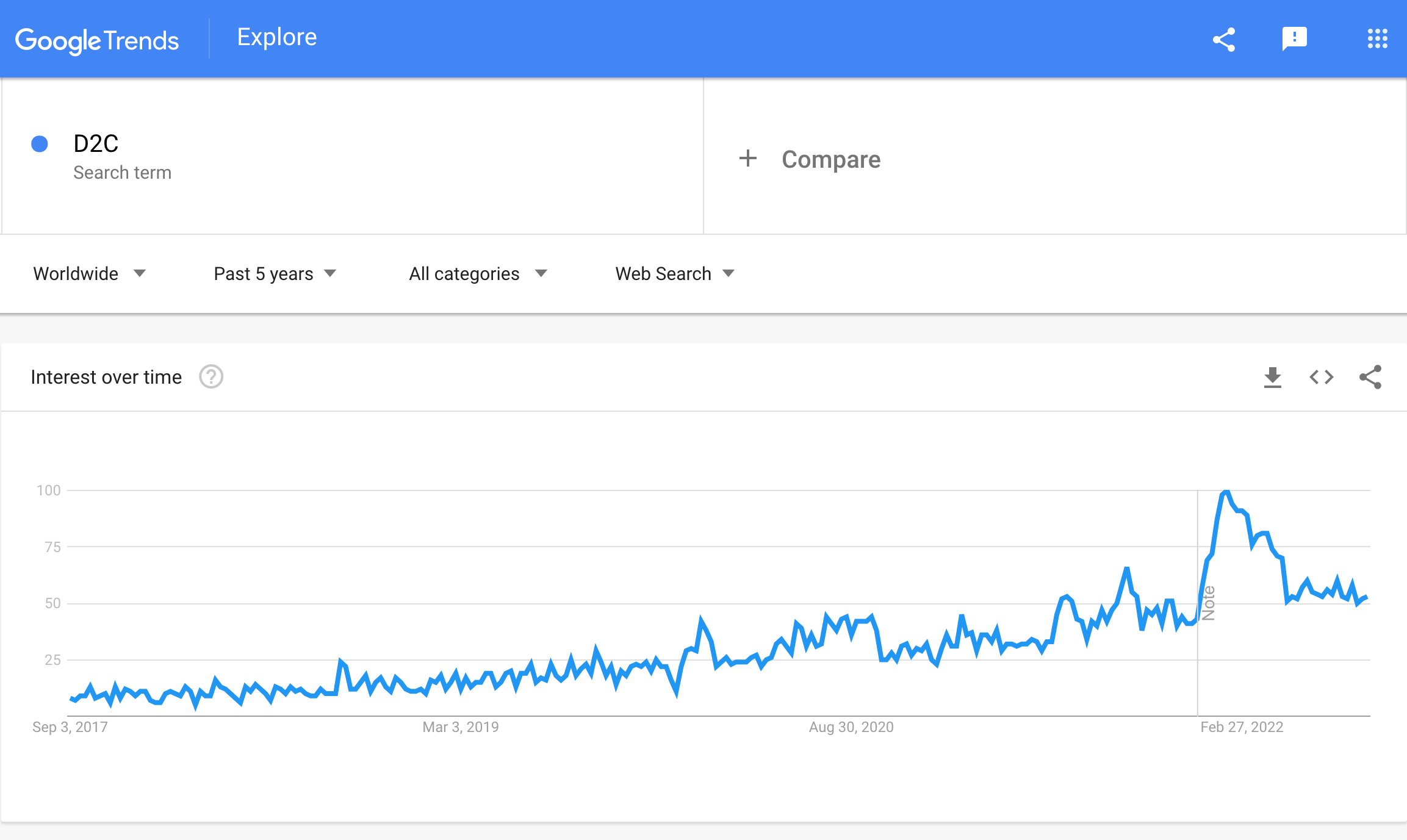In this article, discover what D2C marketing is, why it’s on the rise, the pros and cons of using this model in business, and an example of a successful D2C company.
What is D2C marketing?
D2C (direct-to-consumer) marketing has been around for decades. It’s a marketing strategy that involves manufacturing and selling products to people directly, eliminating the use of wholesalers and retailers. In other words, the sales process is less interrupted and more tailored to the customer. Nowadays, that sales process tend to happen on e-commerce websites and even social media instead of physical stores.
While there is no single recipe for success in the direct-to-consumer market, there are some key characteristics that successful D2C brands share. These attributes include:
- Bringing measurable innovations to well-known products or services
- Investing heavily in brand design at an early stage
- Upholding transparency to back up a bigger purpose
- Delivering educational, interactive, and social experiences
- Listening and responding to customer needs
- Converting customers into fans
- Focusing on digital marketing and data
- Nailing the brand website’s look, feel, and messaging.
But mirroring these traits of prosperous D2C brands is not enough. There’s a lot more to a direct-to-consumer model than you might think.
What’s so good about D2C marketing?
The D2C sector flourished during the height of the pandemic. While traditional retailers struggled with broken supply chains and rapidly changing consumer needs, D2C brands came out as clear winners. How so? Their personalized, highly innovative, and cost-effective approaches.
Also, the direct consumer interaction that occurs from start to finish improves internal data and removes the risk of intermediary retailers warping messages. In that light, the D2C marketing model provides a boost in reach and communication with a brand’s target audience. That’s why D2C companies can increase affinity with their customers and enhance their experiences.
After all, the point of production is to provide solutions to people and not make profit the sole, boring reason for being in business.
D2C marketing – it’s growing!
Although the pandemic clearly contributed to a surge in D2C popularity, the graph below shows its acceleration as a trend.
The high search volume from this year indicates that more brands want to choose a D2C marketing model. This means more brands will likely go digital to reach a wider consumer audience and avoid the high overheads of renting physical space. What’s more, this shift to e-commerce supplements a global remote workforce. And if you haven’t noticed yet, Akepa embraces this remote working drift.
If you’re still not convinced of D2C’s merits, here are a few benefits of taking the direct route to the audience you want to reach.
D2C marketing advantages
- Affordable marketplace entry. It’s not that difficult to quickly set up an online store using platforms such as BigCommerce or Shopify.
- Direct control over brand presence. A company has the authority over its brand messaging, reputation, and customer service.
- Direct access to customer data. D2C marketing lets an organization get closer to the target audience – to location, social media profiles, and purchasing preferences. This means a brand can create personalised experiences.
- No cap on the number of products. Amazon aside, most leading brands want sellers to have only a small portfolio of products.
- High-profit margins. Cutting out intermediaries allows a D2C brand to maximise revenue and further invest in marketing strategies.
- A stronger relationship with customers. D2C marketing allows the opportunity to engage directly with the target audience, leading to more trust and customer loyalty.
- Greater innovation. Products can be manufactured on a small scale to test a target audience’s response and gather feedback to refine the product.
These D2C marketing pros paint a pretty picture on the business canvas. Yet, that’s not to say that D2C marketing is the best approach for every brand. There are some cons too…
D2C marketing disadvantages
In the precariousness of the modern marketing landscape, brands across every sector are facing challenges.
Some D2C marketing disadvantages include:
- Difficulty to convert. When starting out, many D2C brands offer free trials or low-cost products to lure people in. While this strategy can prove effective, some folk end up cancelling trials before any payment is due.
- Need for a variety of skills. Knowledge in several fields is essential to D2C brands – from marketing, to web development, to customer service, all the way through the production process.
- Lack of prioritization. Old-school leadership often treats D2C as an afterthought, preferring other priorities that are better understood.
- Supply chain hassles. A brand that creates its own products can potentially run into stock issues.
- Managing customer returns. D2C returns can be a major issue, as they can cut profits, demand larger warehouse space and additional workers, and require dealing with wonky logistics.
- Increased competition. A natural side effect of D2C’s lower barriers to entry is that a plethora of brands are jumping on board. In other words, the pressure builds to have a distinct brand identity, unique selling point, and extraordinary value proposition to stand out from the crowd.
Despite these few drawbacks, it’s relatively easy to adopt a D2C model.
D2C marketing strategies that work
The type of marketing a company implements makes or breaks its brand. But effective marketing requires knowing how to convey a brand message to a target audience to drive sales and growth.
Here are some of the top D2C marketing strategies that can help sustain brand growth throughout 2022 and beyond.
- Simplifying products
- Tapping into influencer marketing
- Embracing user-generated content
- Creating branded content
- Providing superior customer support online
- Making quick decisions based on data
- Focusing on customer retention
- Offering a generous return policy
- Rapidly trying and testing new approaches
And on that note, meeting the needs of eco-minded folk requires setting a long-term sustainability agenda that gets some goodwill going.
Sustainability benefits
People have grown sceptical of brands, watching a company’s every move. With that in mind, companies are compelled to lift the veil on internal matters such as sourcing, manufacturing, and supply chains. This transparent approach kindles trust and thereby generates more sales. Brands that don’t prioritise a sustainable business model may just vanish into thin air with this new generation of conscious buyers.
According to The Economist Intelligence Unit and LLamasoft, “More than a third of retail executives worldwide noted growth opportunities and cost savings as top reasons to adopt a strategy around supply chain sustainability.” That said, D2C brands clearly have the edge in terms of blending sustainability into their supply chain – as is the case with the sustainability-focused shoe crafters, AllBirds.
A standout D2C brand: AllBirds

In the past, popular brands manufactured shoes of dubious quality at the expense of the environment. Rampant consumption of these fast fashion products has been detrimental to the overall health of the planet.
AllBirds is one of the brands changing the paradigm.
The D2C brand ditched synthetic polyester and started manufacturing sustainable shoes using natural material. To begin with, the company faced multiple difficulties since a sustainable manufacturing infrastructure was non-existent. Still, the organization conquered those early challenges to create a lasting brand. As a B Corp, AllBirds consider environmental conservation as non-negotiable and have prioritised reducing its environmental impact from day one.
What makes AllBirds an innovative brand in the D2C footwear industry is the way the company interacts with customers and its choice to refine products to their simplest form. The business operates exclusively in a direct-to-consumer model and draws on its reductive design philosophy to create a differentiated customer experience. This is why this D2C company is now valued at over $1 billion.
View AllBird’s sustainability report here.
Another example of a successful D2C brand is one of our own clients:
SANVT

We asked founder, Benjamin Heyd, for an insightful quote about the D2C model. He wrote back to us and said:
“Being able to sell directly to consumers has been the true enabler to put our brand’s philosophy into action. At SANVT, we want to offer outstanding quality at a fair prices. In traditional (fashion) business models this is not possible, as whole and retail stores add extra margin, ultimately resulting in higher prices. We’ve cut out those middlemen, and by selling online from our warehouse in Germany, we’re able to keep our markup at 2-3x rather than the traditional 6-8x.”
D2C is likely here to stay
All things considered, the desire for more authentic brand engagement continues to rise — which is a sign that the direct-to-consumer model might be here to stay. However, there are questions that surround keeping the D2C model viable into the future. It’s going to be interesting to see how D2C brands remain at the vanguard of marketing and customer service.
Akepa helps all sorts of sustainable brands to grow and succeed, including many D2C brands. If you’d like to discuss how we can help, then get in touch.




Leave a Reply